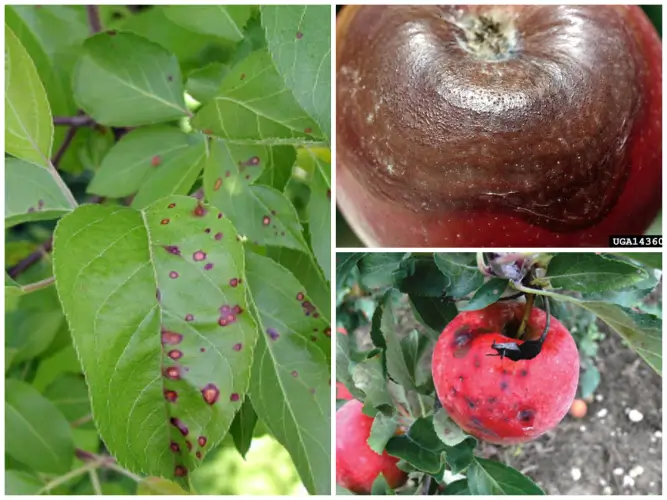Apple Black Rot: Causes, Symptoms, and Management
Publish Date: 2024-12-03
Apple black rot, caused by the fungus Botryosphaeria obtusa, is a significant disease affecting apple orchards worldwide. This disease impacts not only the fruit but also the leaves and branches of apple trees, leading to reduced yield and overall tree vigor. Understanding its symptoms, lifecycle, and management strategies is essential for maintaining healthy and productive orchards.

What is Apple Black Rot?
Black rot is a fungal disease that thrives in warm, humid conditions. The fungus primarily infects apple trees but can also affect other members of the Rosaceae family. It causes fruit rot, leaf spots, and cankers on branches, making it a major concern for apple growers. Left unmanaged, black rot can severely weaken apple trees and diminish fruit quality.
Symptoms of Apple Black Rot
Black rot symptoms vary depending on the part of the tree affected. These include:
On Fruit (Frogs-Eye Rot)
- Circular, brown, and slightly sunken lesions appear on infected fruits.
- The lesions enlarge over time, often developing concentric rings.
- In advanced stages, the fruit may shrivel and become mummified, clinging to the tree.
On Leaves
- Small, round spots with purple margins and tan or brown centers develop, known as "frog-eye" spots.
- Severe infections can cause premature leaf drop.
On Branches and Trunks
- Dark, sunken cankers form on branches or trunks, often oozing sap.
- Over time, the cankers expand and girdle branches, leading to dieback.
The Life Cycle of Botryosphaeria obtusa
The black rot fungus has a complex lifecycle that involves multiple infection stages:
-
Overwintering:
- The fungus overwinters in infected fruit mummies, fallen leaves, and cankers on branches.
-
Primary Infection:
- In spring, spores from overwintered material are released during wet conditions, infecting new growth.
-
Secondary Infection:
- Throughout the growing season, the fungus produces additional spores that spread to healthy tissues via wind or rain.
Favorable Conditions for Black Rot
The fungus thrives under specific environmental conditions, including:
- Warm Temperatures: Ideal range is between 70°F and 80°F (21°C to 27°C).
- High Humidity: Prolonged wetness on fruit, leaves, or bark encourages spore germination.
- Tree Stress: Stressed trees, particularly those with wounds or poor nutrition, are more susceptible to infection.
Management of Apple Black Rot
Effective management of black rot requires an integrated approach that combines cultural practices, chemical treatments, and vigilant monitoring.
1. Cultural Practices
- Sanitation:
- Remove and destroy infected fruit mummies, fallen leaves, and pruned branches to reduce fungal inoculum.
- Pruning:
- Prune out cankers during dry weather, ensuring cuts are made well below the affected area.
- Tree Health:
- Maintain tree vigor through proper fertilization, irrigation, and pest management.
2. Chemical Control
- Fungicides:
- Apply protectant fungicides containing captan, mancozeb, or thiophanate-methyl during key infection periods.
- Begin applications at bloom and continue at regular intervals, especially during wet weather.
- Timing:
- Monitor weather conditions and apply fungicides before prolonged rain events.
3. Resistant Varieties
- Plant apple varieties that show greater resistance to black rot, such as Liberty or Enterprise.
4. Orchard Design
- Ensure proper spacing and pruning to improve air circulation and reduce humidity within the canopy.
Economic Impact of Black Rot
Black rot can significantly impact orchard productivity and profitability. Key effects include:
- Reduced Fruit Quality: Infected fruits are often unmarketable due to unsightly lesions and decay.
- Yield Losses: Severe infections can lead to substantial fruit drop and tree decline.
- Increased Costs: Effective management requires investments in labor, fungicides, and cultural practices.
Conclusion
Apple black rot is a challenging disease, but with proactive management, its impact can be minimized. Regular orchard sanitation, timely fungicide applications, and proper tree care are essential for controlling this disease. By understanding its symptoms and lifecycle, apple growers can protect their orchards and ensure high-quality, marketable fruit.
References:
This article is based on original agricultural knowledge and best practices for disease management. For region-specific advice, consult your local agricultural extension service.